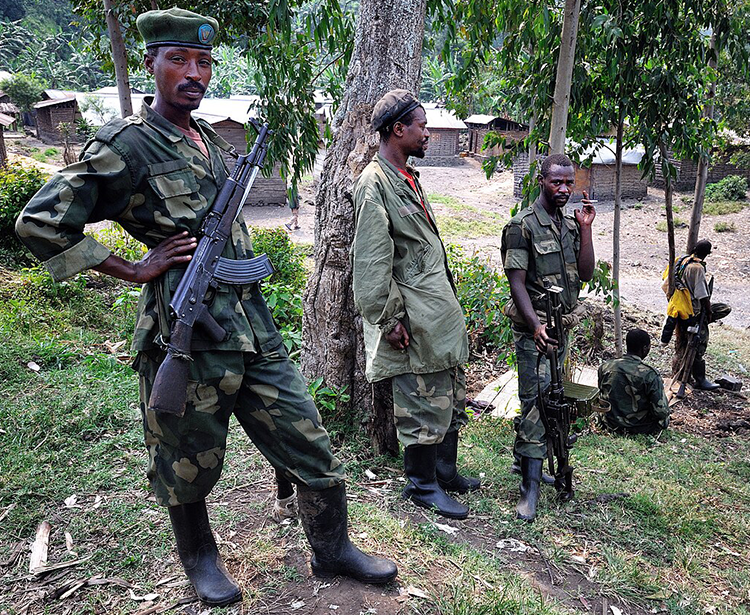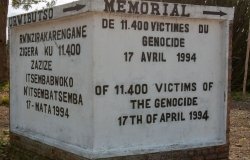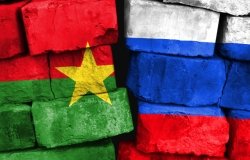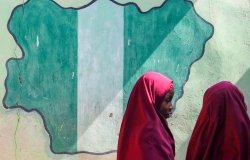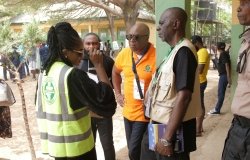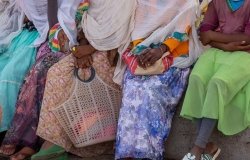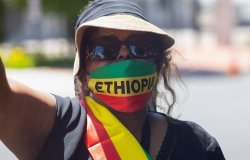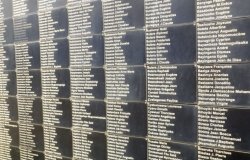
A blog of the Africa Program
Mandates and Mixed Success: The EACRF’s Enigmatic Pursuit of Peace in Eastern DRC
On October 24, 2023, fighting erupted in the Kibumba area of the Democratic Republic of the Congo (DRC) between the East African Community Regional Force (EACRF) and the March 23 Movement (M23), one of the country’s most prominent rebel groups. The EACRF, comprising troops from Burundi, Kenya, South Sudan, Tanzania, and Uganda, was initially deployed to DRC in November 2022 with a directive to “contain, defeat, and eradicate negative forces” in the eastern part of the country.
This breakdown of the ceasefire between Congolese forces and the M23 not only resulted in the tragic death of one Kenyan soldier but also reinforces the broader criticism directed at the EACRF for its inability to quell the persistent violence that has plagued the Congolese security landscape for decades. As December approaches, which marks the scheduled end of the regional force’s mandate, now is a vital moment to examine the force’s role and the relative success—or lack thereof.
Issue of Mandate
Despite the ostensibly clear phrasing of the EACRF’s mandate, much confusion and inconsistency has enshrouded the force’s objectives. Despite its established peace enforcement mandate, the force’s officials have maintained that the EACRF was intended to be “neutral” and can only engage in military confrontation as a “last resort.” Indeed, the EACRF has been actively engaged in pursuing political solutions to the conflict by encouraging dialogue between the Congolese government and the sundry rebel groups operating in the east.
However, the perceived passivity of the regional force has generated negative reviews from Congolese leaders and locals alike. President Felix Tshisekedi has repeatedly criticized the EACRF for lacking sufficient aggression in response to the M23. Tshisekedi called for the force to attack M23 rebels, an action that he claimed was within the force’s unfulfilled mandate. In a February 2023 announcement, the Congolese government asserted that the EACRF’s mandate was “unequivocally offensive”—reaffirming the antipodal understandings of the force’s mission. East Congolese residents have similarly criticized the perceived failure of the EACRF. In the words of one local, “The M23 are still there. The arrival of the EAC soldiers has changed nothing.” This dissatisfaction culminated in a protest on August 30, calling for the departure of the EACRF and other foreign forces.
In this complex web of mandates, interests, and security dynamics, the EACRF’s journey in the DRC remains a puzzle with no easy solution, much like the intricate geopolitics it navigates.
Mixed Metrics of Success
Given the ambiguity surrounding the EACRF’s mandate, any assessment of the force’s efficacy becomes increasingly difficult. However, looking at the EACRF’s engagements since its deployment using data compiled and analyzed by the Armed Conflict Location & Event Data Project (ACLED) provides a better understanding of the nature with which the force interacts with rebel groups.
First, the EACRF has overwhelmingly eschewed violence. Of 61 recorded EACRF engagements, 53 of them (86.9%) were strategic developments (rather than armed clashes or one-sided violence). Moreover, 33 of these 53 engagements (54.1%) were non-violent transfers of territory from rebel groups (mainly M23) to the EACRF. Such findings reflect the regional force’s preference for negotiating with M23, supporting accounts that the force has had “tremendous success in […] handing over the previously occupied territories to the regional force.” Of the 33 instances of successful transfer, there was only one incident of a non-state actor (M23) taking back territory, which took place in April 2023 in North Kivu.
Furthermore, for all the Congolese government’s insistence about the force’s offensive mandate, the data more closely mirrors the EACRF’s narrative—that the force will only engage in armed confrontation if necessary. In the examined period, there were only six incidents of battles with armed groups: M23 (1 event), Coalition of Movements of Change of the Congo (1), Awakening of Patriots for the Liberation of Congo (EPLC) (2), and unidentified groups (2). Evidently, the EACRF has been successful in ensuring the handover of territories from M23.
On the other hand, another manner of measuring success is the change in activities of rebel groups since the deployment of the regional force. ACLED data on M23 from its resurgence in late 2021 through August 2023 reveals an interesting trend: following the first deployment of EACRF troops in November 2022 (light blue box), there has been a substantial increase in all types of examined incidents. However, If the analysis is restricted to when the EACRF was fully operational in April 2023 (darker blue box), it shows a dramatic decrease in battles, explosions, and strategic developments.
The increased frequency of strategic developments following EACRF’s initial deployment suggests that the regional force has likely played a constructive role in facilitating non-violent transfers of territory. The surge in armed clashes between late 2022 and early 2023 probably stems from renewed hostilities between M23 and the Congolese armed forces, the FARDC—conflicts that the EACRF has sought to avoid. However, as EACRF consolidated its presence and began engaging with the M23, the rebel group’s incidences of battles significantly decreased. This shift could be attributed to the EACRF reaching a critical operational mass that influenced M23’s strategic calculations. Alternatively, it could be the result of the FARDC stepping back and allowing the regional force to assume a greater leadership role, reducing confrontations between the FARDC and M23. While establishing a direct causal relationship between the fully deployed EACRF and this decline in armed conflict is challenging, the clear correlation does offer preliminary evidence of the regional force’s possible efficacy.
Future Challenges
If the present reality of eastern DRC is not challenging enough--especially for an entity that is only months old in a conflict with decades of history--the EACRF will likely face other obstacles that could impair its efficacy.
One consideration is the composition of the EACRF and how its individual countries’ interests might be at odds with the force’s mission. For instance, Ugandan troops are largely operating in areas populated by the Allied Democratic Forces (ADF), a Ugandan rebel coalition, and in areas where substantial Ugandan oil deposits and infrastructure exist. Burundi’s presence in South Kivu likely reflects the country’s interest in countering Burundian rebel forces, such as the National Liberation Forces or the Popular Forces of Burundi. Kenya, which is the leader of the EACRF, has repeatedly stated that its priority is the political process between the Congolese government and M23 and therefore might drive the force to avoid violence. While these competing interests are impossible to eliminate, it is crucial for the EACRF to ensure a unified, coherent mission among its member countries, even while acknowledging these distinctive individual interests. Regular dialogues and specific rules of engagement can potentially aid in reducing the adverse consequences of any conflicts of interest among the contributing nations.
Another possible challenge for the EACRF might be the deployment of the Southern Africa Development Community’s (SADC) novel SADC Mission in the DRC (SAMIDRC), which is expected to be deployed with a 12 month-mandate to eastern DRC on September 30. It is still unclear how EACRF and SAMIDRC would co-exist, and existing challenges of coordination between the United Nations Organization Stabilization Mission in the Democratic Republic of the Congo (MONUSCO) and EACRF indicate these difficulties would likely persist. As such, the EACRF and its relevant counterparts, including MONUSCO and SAMIDRC, must prioritize organizing and deconflicting their activities. These entities could work together to create and deploy information-sharing mechanisms that allow the EACRF to better communicate and coordinate with the other actors on the ground. Part of these efforts would require clarifying the EACRF’s mandate as to generate a clearer shared vision of how the regional force fits into the Congolese security landscape.
In this complex web of mandates, interests, and security dynamics, the EACRF’s journey in the DRC remains a puzzle with no easy solution, much like the intricate geopolitics it navigates.
Stephanie Lizzo holds a master's degree in international security with concentrations in Intelligence and African Studies from Sciences Po, Paris. She is currently a Junior Policy Analyst at the Organization for Economic Co-operation and Development (OECD).
The opinions expressed on this blog are solely those of the authors. They do not reflect the views of the Wilson Center or those of Carnegie Corporation of New York. The Wilson Center’s Africa Program provides a safe space for various perspectives to be shared and discussed on critical issues of importance to both Africa and the United States.
About the Author

Stephanie Lizzo
Junior Policy Analyst, the Organization for Economic Co-operation and Development (OCED).

Africa Program
The Africa Program works to address the most critical issues facing Africa and US-Africa relations, build mutually beneficial US-Africa relations, and enhance knowledge and understanding about Africa in the United States. The Program achieves its mission through in-depth research and analyses, public discussion, working groups, and briefings that bring together policymakers, practitioners, and subject matter experts to analyze and offer practical options for tackling key challenges in Africa and in US-Africa relations. Read more
